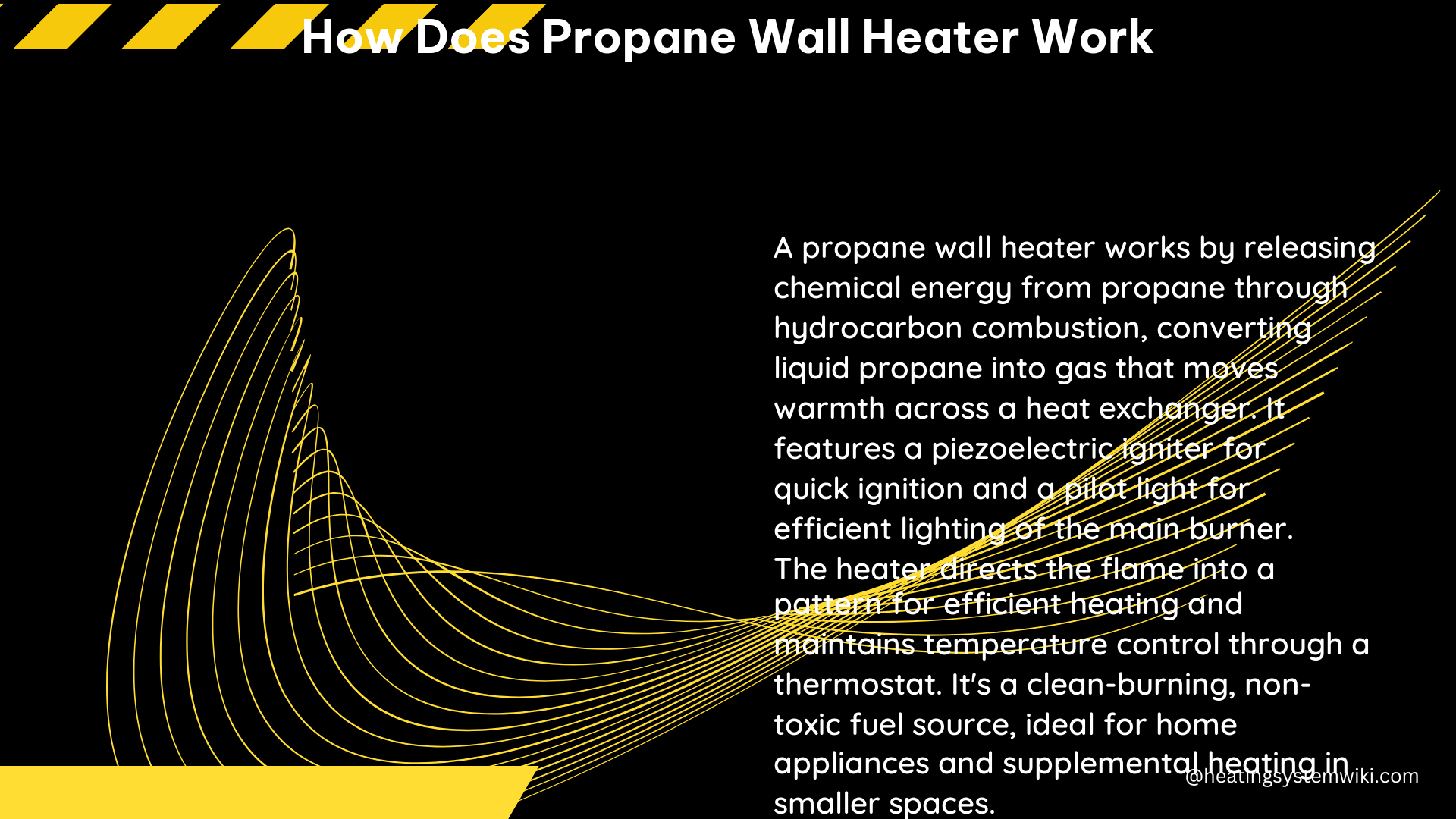A propane wall heater is a compact and efficient heating solution for smaller spaces or problem rooms that don’t get warm enough with central heating. It works by converting liquid propane into a gas that moves warmth across a heat exchanger, which then distributes the heat through the duct system and vents in the room.
Understanding the Propane Wall Heater Mechanism
Propane Tank and Regulator
Propane wall heaters use liquid propane as a fuel source, which is stored under pressure inside a tank. The regulator is a crucial component that controls the high-pressure gas that exits the propane tank and reduces it to a safe level. The force of the spring against the diaphragm in the regulator exerts a back pressure, which retards the flow of the high-pressure gas in the tank. This is why it’s important to have the right size and type of regulator to ensure proper operation.
Service Lines and Connections
The heater’s service lines should be compatible with the heater’s pressure or it may not work properly. Copper lines with flared fittings are the most common, but pre-made rubber liquid propane lines can also be used for shorter runs between the tank and appliance. Dual-tank hook-up kits are available for those who have two LP tanks on hand, allowing for seamless switching between tanks when one runs out.
Ignition and Thermocouple
To light and operate a propane wall heater, the user must turn the arrow on the top of the heater to the pilot position and hold the pilot light down. Then, they need to hit the igniter to light the flame. Once the thermocouple gets hot, the flame will stay on. The user can then adjust the settings to control the heat output.
Safety Considerations
It’s important to run dehumidifiers and have carbon monoxide detectors when using propane wall heaters to ensure safety and prevent mold or mildew. Proper installation, placement, and maintenance are crucial for safe and efficient operation.
Technical Specifications

- Propane wall heaters use liquid propane as a fuel source, which is stored under pressure inside a tank.
- The regulator controls the high-pressure gas that exits the propane tank and reduces it to a safe level, typically between 11 and 14 inches of water column (WC).
- The service lines should be compatible with the heater’s pressure, which is usually between 11 and 14 inches WC. Copper lines with flared fittings are the most common, but pre-made rubber liquid propane lines can also be used for shorter runs.
- Dual-tank hook-up kits are available for those who have two LP tanks on hand, allowing for seamless switching between tanks when one runs out. These kits typically include a manifold, hoses, and necessary fittings.
- The ignition system in propane wall heaters uses a pilot light and a thermocouple to ensure the flame stays lit. The thermocouple senses the pilot light’s heat and opens the gas valve to allow the main burner to ignite.
- Propane wall heaters are designed to be energy-efficient, with typical BTU ratings ranging from 10,000 to 30,000 BTU per hour, depending on the model and size.
- Proper installation, placement, and maintenance are crucial for safe and efficient operation, including the use of dehumidifiers and carbon monoxide detectors.
DIY Guide: Installing and Operating a Propane Wall Heater
-
Purchase the Necessary Components: Acquire a propane wall heater, propane tank(s), regulator, service lines, and any additional accessories or tools required for installation.
-
Install the Regulator: Attach the regulator to the propane tank, ensuring it is the correct size and type for your heater’s pressure requirements, typically between 11 and 14 inches WC.
-
Connect the Service Lines: Connect the service lines from the regulator to the heater, using either copper lines with flared fittings or pre-made rubber liquid propane lines for shorter runs. Ensure the lines are compatible with the heater’s pressure.
-
Install a Dual-Tank Hook-Up Kit (if applicable): If you have two LP tanks, install a dual-tank hook-up kit to allow for seamless switching between tanks when one runs out.
-
Follow the Manufacturer’s Instructions: Carefully read and follow the manufacturer’s instructions for lighting and operating the propane wall heater. This typically involves turning the arrow on the top of the heater to the pilot position, holding the pilot light down, and hitting the igniter to light the flame.
-
Adjust the Settings: Once the thermocouple gets hot and the flame stays on, you can adjust the settings to control the heat output as needed.
-
Ensure Safety and Maintenance: Run dehumidifiers and have carbon monoxide detectors in the room to ensure safety and prevent mold or mildew. Regularly maintain the heater according to the manufacturer’s recommendations.
By following these steps and the technical specifications, you can safely and efficiently install and operate a propane wall heater in your home or small commercial space.
References
- How Does Propane Heat Work? | Propane Heating Systems. (n.d.). Retrieved from https://www.propanemissouri.com/info/how-does-propane-heat-work/
- Installing a propane heater – Backwoods Home Magazine. (n.d.). Retrieved from https://www.backwoodshome.com/installing-a-propane-heater/
- How to light and operate a gas wall heater – YouTube. (2021, November 4). Retrieved from https://www.youtube.com/watch?v=GBG4zwHHMw4
- What is a propane wall heater? (2020, March 9). Retrieved from https://www.fallriverpropane.com/2020/03/09/what-is-a-propane-wall-heater/
